
A platform that encourages healthy conversation, spiritual support, growth and fellowship

NOLACatholic Parenting Podcast
A natural progression of our weekly column in the Clarion Herald and blog

The best in Catholic news and inspiration - wherever you are!
Many liturgical rites, but all one Catholic Church
-
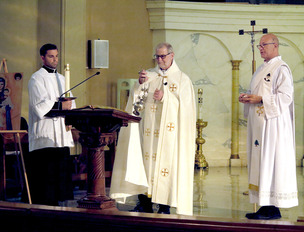
By Christine Bordelon
Clarion Herald
A Divine Liturgy celebrated last month at St. Joseph Church on Tulane Avenue was a little different than your weekly Roman Catholic Mass.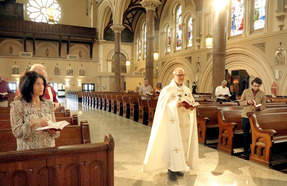 While most Catholics would immediately recognize symbols of the Mass, they would quickly sense an abundance of singing in Syriac and incense.
While most Catholics would immediately recognize symbols of the Mass, they would quickly sense an abundance of singing in Syriac and incense.
That’s because the liturgy, celebrated by Vincentian Father Gilbert Walker, was a Maronite Catholic liturgy.
“We sing a lot more than in a regular Roman Catholic liturgy,” Father Walker said.
The Maronite Catholic rite, one of the 24 rites of the Catholic Church, is the only Eastern one (there are 23) that has maintained unbroken communion with the Holy See, said Father Walker, who has bi-ritual Maronite and Roman Catholic faculties.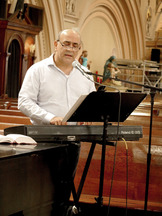 Cantor/keyboardist Elias Khalaf set the tone with beautiful music before and during the liturgy. Like many in the Maronite Catholic Church, Khalaf usually attends Mass at a Roman Catholic church since there are few Maronite communities. Khalaf is a parishioner at St. Clement of Rome in Metairie.
Cantor/keyboardist Elias Khalaf set the tone with beautiful music before and during the liturgy. Like many in the Maronite Catholic Church, Khalaf usually attends Mass at a Roman Catholic church since there are few Maronite communities. Khalaf is a parishioner at St. Clement of Rome in Metairie.
In Eastern rite tradition, four parts of the liturgy are sung in Syriac. The entrance is a dialogue between the priest and the people. The Trisagion (Holy God, Holy Mighty One, Holy Immortal One, have mercy on us ) is sung by the priest and people. After the Liturgy of the Word and the Creed, prayers are offered in the approach to the altar. Finally, the words of Institution (Jesus’ words over the bread and wine) are prayed by the priest and other celebrants at the altar.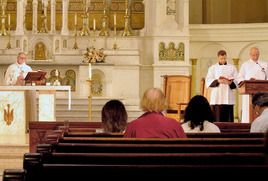 Incense: Visual sign of prayer
Incense: Visual sign of prayer
Incensing is offered numerous times: at the entrance (incensing the cross, the altar, the priest and the people); the Book of the Gospel just before the reading is proclaimed; and at the presentation of the gifts to the altar. Then, the altar and the people are incensed again.
“(Incense) symbolizes our prayers rising up to God,” Father Walker said. It is a sign that God is present at the altar, that the priest and people are symbols of Christ, and that his word is in the Gospel.
“Jesus Christ, our Lord, accept these prayers and the incense we have offered,” Father Walker prayed, as the congregation followed in their own missalettes written in English, Arabic and Syriac languages.
Because the Maronite liturgical calendar is different from the Roman Catholic calendar, Sunday readings are different. The Oct. 22 readings were from Proverbs and St. Paul’s Letter to the Galatians and the Gospel from Matthew 25, telling the story of the wise and foolish servants who each were given talents.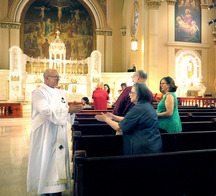 Develop our talents
Develop our talents
“The Gospel was about relationships, trust and doing what you’ve been charged to do by our Lord,” Father Walker said. He said the master trusted the servants just as God trusted us with the gifts he has given us. God trusted us enough to send his son Jesus to show us how much he loves us.
“Our gifts are the sign of the love God has for us,” he said. “It’s not only our responsibility to develop our talents but also to develop relationships with God and others. … Our relationship with God will last until eternity.”Father Walker said God calls us to strengthen our relationships of friendship, love and family ties.
“God calls us to be one and treat each other with love and respect,” he said, reflecting on the war-ravaged Middle East where “God’s peace is so needed and the voices of reason need to be heard.”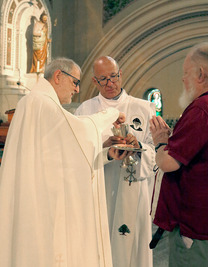
During the liturgy, other noticeable changes included the Holy Spirit being invoked (the Epiclesis) over the bread and wine after – not before – they are consecrated. Communion is given on the tongue, not in the hands (although it is permissible).
And, for the sign of peace, Father Walker clasped the hands of visiting Sub-Deacon Paul Bolus from Birmingham, who walked down to the pews with an altar server to offer peace to worshippers.
“The peace is brought from the altar to the congregation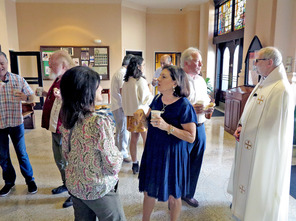 by a deacon or altar server – not just one another,” Father Walker said. “It comes from the altar down to the people.”
by a deacon or altar server – not just one another,” Father Walker said. “It comes from the altar down to the people.”
In the Maronite Church’s ordination rite, the ordaining bishop places one hand on the consecrated Eucharist on the altar and his other hand on the head of the man being ordained.
“This signifies very clearly that the ordination comes from Christ through the bishop to the candidate being ordained,” Father Walker said.
History of Maronites
The Maronite Catholic Church’s origins are traced to the Christians of Lebanon and Syria. It is named after St. Maron, a holy monk who was born in Syria in the fourth century. When he died in 410, many of his followers moved to the mountains of Lebanon to escape persecution. Now, “Maronite Catholics are found all over the world,” Father Walker said.
The church is governed by a Synod of Bishops, led by the Maronite Patriarch of Antioch, all in communion with, and under the authority of Pope Francis.
There are two eparchies (dioceses) in the United States: the Eparchy of St. Maron of Brooklyn (encompassing the East Coast), and the Eparchy of Our Lady of Lebanon of Los Angeles (the rest of the country), led by current bishop, the Most Reverend A. Elias Zaidan, who lives in Los Angeles.
“The church is one,” attendee Michael Scioli said. “Every Catholic should be aware of the different rites of the Catholic Church, and everyone’s spiritual life can be deepened by being present in the different liturgies.”
Scioli said widening our minds and hearts will prepare a deeper space in which God can dwell.
“I really desired in my heart to have orthodoxy in my life,” said Scioli, who had fallen away from the Catholic Church but returned through beloved priest friend, Father Stanley Klores, the former pastor of St. Patrick Church in New Orleans.
Scioli is studying theology at the Antiochian House of Studies and expecting his first child.
Local writer Kevin Credo became aware of the Maronite Church in 2021.
“The Maronites offer us a very ancient form of Catholicism, bearing witness to the often-overlooked realities of Christianity’s continuous presence in the Levant (in West Asia) as well as the rich diversity within the Catholic Church herself,” Credo said.
Just getting established
The recent Maronite liturgy was only the seventh time since the Maronite Eastern Rite Catholic community has celebrated the liturgy in the Archdiocese of New Orleans at St. Joseph Church. (The eighth Maronite liturgy was celebrated Nov. 19.)
“When I found out that they were having a Maronite service, I had to go in memory of my dad,” Syria Movgrabi said. She usually attends St. Jerome Roman Catholic Church in Kenner, but her father is a Maronite Catholic from Jounieh the area, near Beirut in Lebanon.
Gerard Mahlmeister and his wife Kimbra, both Roman Catholics, were also in attendance. Kimbra’s Metaxas family is from Lebanon, and she’s been searching for a local Maronite church for the past 20 years.
“There’s a transcendence here,” she said. “It’s one of the most beautiful forms of worship. All the chanting and music bring you closer to God.”
Other Maronite Catholic liturgies in Louisiana are at St. Sharbel Maronite Catholic Church in Baton Rouge (the first Maronite Church in Louisiana), whose administrator, Father Alex Harb, celebrates the Maronite Divine Liturgy weekly and also monthly at St. Patrick Catholic Church in Lafayette; and at St. Peter Catholic Church in Covington.
The New Orleans community is awaiting mission church status in the Archdiocese of New Orleans, Father Walker said. The December liturgy will be on Christmas Eve at 12:30 p.m. at St. Joseph. A gathering with food will follow.
“Celebrated before anybody else in the Archdiocese of New Orleans,” Father Walker said.
Visit the website: https://eparchy.org/
[email protected]




